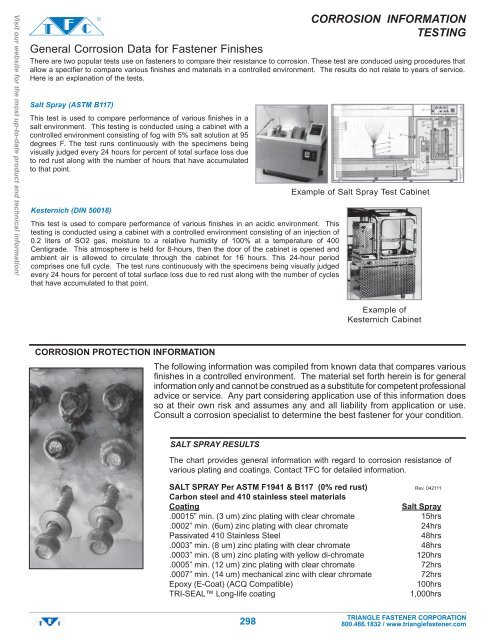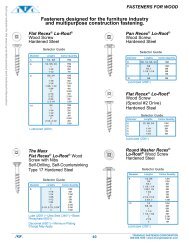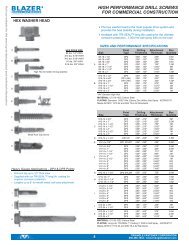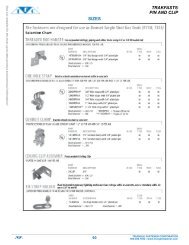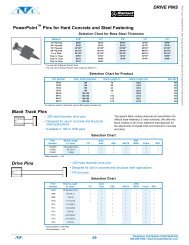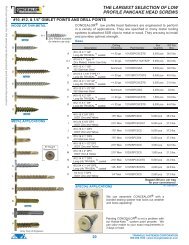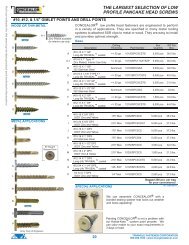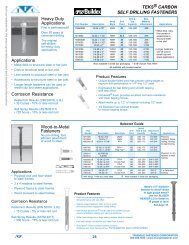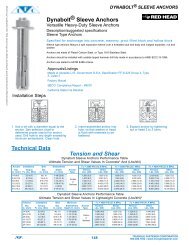Plating - Triangle Fastener
Plating - Triangle Fastener
Plating - Triangle Fastener
You also want an ePaper? Increase the reach of your titles
YUMPU automatically turns print PDFs into web optimized ePapers that Google loves.
Visit our website for the most up-to-date product and technical information!<br />
General Corrosion Data for <strong>Fastener</strong> Finishes<br />
There are two popular tests use on fasteners to compare their resistance to corrosion. These test are conduced using procedures that<br />
allow a specifier to compare various finishes and materials in a controlled environment. The results do not relate to years of service.<br />
Here is an explanation of the tests.<br />
Salt Spray (ASTM B117)<br />
This test is used to compare performance of various finishes in a<br />
salt environment. This testing is conducted using a cabinet with a<br />
controlled environment consisting of fog with 5% salt solution at 95<br />
degrees F. The test runs continuously with the specimens being<br />
visually judged every 24 hours for percent of total surface loss due<br />
to red rust along with the number of hours that have accumulated<br />
to that point.<br />
Kesternich (DIN 50018)<br />
This test is used to compare performance of various finishes in an acidic environment. This<br />
testing is conducted using a cabinet with a controlled environment consisting of an injection of<br />
0.2 liters of SO2 gas, moisture to a relative humidity of 100% at a temperature of 400<br />
Centigrade. This atmosphere is held for 8-hours, then the door of the cabinet is opened and<br />
ambient air is allowed to circulate through the cabinet for 16 hours. This 24-hour period<br />
comprises one full cycle. The test runs continuously with the specimens being visually judged<br />
every 24 hours for percent of total surface loss due to red rust along with the number of cycles<br />
that have accumulated to that point.<br />
CORROSION INFORMATION<br />
TESTING<br />
Example of Salt Spray Test Cabinet<br />
Example of<br />
Kesternich Cabinet<br />
CORROSION PROTECTION INFORMATION<br />
The following information was compiled from known data that compares various<br />
finishes in a controlled environment. The material set forth herein is for general<br />
information only and cannot be construed as a substitute for competent professional<br />
advice or service. Any part considering application use of this information does<br />
so at their own risk and assumes any and all liability from application or use.<br />
Consult a corrosion specialist to determine the best fastener for your condition.<br />
SALT SPRAY RESULTS<br />
The chart provides general information with regard to corrosion resistance of<br />
various plating and coatings. Contact TFC for detailed information.<br />
SALT SPRAY Per ASTM F1941 & B117 (0% red rust) Rev. 042111<br />
Carbon steel and 410 stainless steel materials<br />
Coating<br />
Salt Spray<br />
.00015” min. (3 um) zinc plating with clear chromate 15hrs<br />
.0002” min. (6um) zinc plating with clear chromate 24hrs<br />
Passivated 410 Stainless Steel<br />
48hrs<br />
.0003” min. (8 um) zinc plating with clear chromate 48hrs<br />
.0003” min. (8 um) zinc plating with yellow di-chromate 120hrs<br />
.0005” min. (12 um) zinc plating with clear chromate 72hrs<br />
.0007” min. (14 um) mechanical zinc with clear chromate 72hrs<br />
Epoxy (E-Coat) (ACQ Compatible)<br />
100hrs<br />
TRI-SEAL Long-life coating<br />
1,000hrs<br />
298<br />
TRIANGLE FASTENER CORPORATION<br />
800.486.1832 / www.trianglefastener.com
Galvanic Corrosion - compatible metals charts<br />
To minimize galvanic corrosion, fasteners should be considered<br />
based on their material compatibility with the substrates.<br />
Determine the materials being fastened and choose a fastener<br />
material that is close in proximity on the chart. The closer together<br />
the material are on the chart the less galvanic action will occur.<br />
Metals listed on the top of the chart (anotic) will corrode faster<br />
than the metals on the bottom of the chart (cathodic).<br />
Contact a corrosion specialist to determine the best material for<br />
your application.<br />
<strong>Fastener</strong> compatibility for metal roofing and wall cladding<br />
Table developed by the Metal Construction Association Members ( Revised by TFC: 12813JS )<br />
<strong>Fastener</strong> Material<br />
Zinc Plated<br />
Steel<br />
Screws 2<br />
Organic<br />
Coated Steel<br />
Screws 2<br />
Hot-Dip<br />
Galvanized<br />
Steel Nails 3<br />
and Screws<br />
Zinc-Alloy<br />
Head Steel<br />
Screws<br />
Stainless<br />
Capped Head<br />
Steel Screws<br />
Corrosion Information<br />
Galvanic Action<br />
300<br />
Series<br />
Stainless<br />
Steel<br />
400<br />
Series<br />
Stainless<br />
Steel<br />
Metal Roof or<br />
Wall Cladding Material<br />
Aluminum<br />
Copper and<br />
Copper Alloys<br />
Unpainted Galvanized Steel Yes 4 Yes Yes Yes Yes Yes No Yes Yes<br />
Painted Galvanized Steel Yes 4 Yes Yes Yes Yes Yes No Yes Yes<br />
Unpainted Galvalume Steel Yes 4 Yes 4 Yes Yes Yes Yes No Yes Yes<br />
Painted Galvalume Steel Yes 4 Yes 4 Yes Yes Yes Yes No Yes 4 Yes 4<br />
Aluminum No Yes 4 Yes Yes No Yes No Yes No<br />
Copper & Copper Alloys No No No No No No No Yes Yes4<br />
Stainless Steel No No Yes Yes Yes Yes Yes Yes Yes<br />
Zinc alloy No No No Yes No Yes No Yes Yes<br />
Chart was revised by TFC based on various panel manufacturer's specifications and actual job-site performace.<br />
Note 1: Cautionary Guideline: This table serves as a guideline for the selection of fasteners used with metal roofing. The performance<br />
of compatible fasteners shown in this table matches the expected life of the metal roof or wall cladding materials. However, in highly<br />
corrosive environments such as heavy industrial, coastal marine, high airborne pollutants or salt spray, preservative treated lumber or<br />
fire-retardant lumber, the compatibility of certain fasteners with metal roofing or wall cladding materials may be affected. In those types of<br />
applications, the manufacturers of the fastener and metal panel will have specific and unique recommendations.<br />
Visit our website for the most up-to-date product and technical information!<br />
In addition, in the event that certain coating barriers are damaged or scratched through to the substrate there is increased potential for<br />
premature corrosion. Care should be taken during installation and during routine maintenance of the panels in order to protect the integrity<br />
of the coatings used for metal panels.<br />
Note 2: Screws should be plated/coated per ASTM F1941<br />
Note 3: Nails should be galvanized per ASTM A153<br />
Note 4: Not recommended for coastal and heavy industrial environments<br />
Special Note: Preservative-Treated Lumber Applications<br />
ACQ, Penta, CA or CBA preservative-treated lumber can be incompatible with certain types of fasteners. In those cases where any type<br />
of metal roof or wall cladding materials are being attached to preservative treated lumber, the following fasteners are not compatible: zinc<br />
plated screws, zinc-alloy headed screws, stainless capped screws, aluminum, copper and copper alloy. When attaching metal panels to<br />
those types of preservative-treated lumber, a moisture barrier should be used between the lumber and the panel material. Metal panel<br />
fasteners that are compatible with preservative-treated lumber are stainless steel fasteners, or hot dip galvanized nails manufactured<br />
to ASTM A153 class D or heavier. Other types of fasteners coated with proprietary anti-corrosive technologies are also available for use<br />
with preservative-treated lumber. In addition, zinc-plated screws can be used in CCA and MCQ pressure-treated lumber.<br />
299<br />
TRIANGLE FASTENER CORPORATION<br />
800.486.1832 / www.trianglefastener.com
Visit our website for the most up-to-date product and technical information!<br />
Characteristics of <strong>Plating</strong>s, Coatings and Finishes<br />
<strong>Plating</strong>, Coating For Use On Degree of<br />
or Finish Corrosion Resistance Characteristics<br />
Rust inhibitors All metals Varies with type Oils, greases, etc. Vary in color and film thickness. Usually applied to black oxide finishes.<br />
Used to protect parts in transit and temporary storage.<br />
Zinc, electroplated All metals Very good Blue to blue-white gray color.<br />
Cadmium, electroplated Most metals Excellent Bright silver-gray, dull gray, or black finish. Particularly effective corrosion<br />
protection in marine applications. Used for decorative purposes. High lubricity.<br />
Clear chromate finish Zinc and cadmium Very good to excellent Clear bright or iridescent chemical conversion coating applied to plated parts to enhance<br />
plated parts<br />
corrosion protection, coloring, and paint bonding.<br />
Dichromate Zinc and cadmium Very good to excellent Yellow, brown, green or iridescent colored coating same as clear chromate.<br />
plated parts<br />
Color chromate finish Zinc and cadmium Very good to excellent Olive drab, blue, gold, bronze, etc. Same as clear chromate.<br />
plated parts<br />
Corrosion Information<br />
PLATINGS & APPLICATIONS<br />
Zinc or Manganese Steel Good Black in color. Added protection when oiled with a non-drying petroleum oil containing<br />
Phosphate<br />
corrosion inhibitors. Good lubricity.<br />
Color phosphate coatings Steel Superior to regular phosphate Chemically produced color coating. Available in blue, green, red, purple, etc.<br />
and oiled surfaces<br />
Hot-dip zinc All metals Very good Gives maximum corrosion protection. Dull grayish color Necessitates thread size<br />
adjustments to permit assembly.<br />
Hot-dip aluminum Steel Very good Gives maximum corrosion protection. Dull grayish color. Necessitates thread size<br />
adjustments to permit assemblably.<br />
Mechanically deposited Zinc Steel Very good Dull gray, smooth finish. Corrosion protection depends on coating thickness.<br />
Good coverage in recesses and thread roots.<br />
Tin, electroplated All metals Silver-gray color. Excellent corrosion protection for parts in contact with food.<br />
Hot-dip tin All metals Excellent Same as electroplated but thickness is harder to control.<br />
Lead-tin Steel, usually Fair to good Silver-gray, dull coating. Applied by hot-dip method. Helps lubricity.<br />
Silver, electroplated All metals Excellent Decorative, expensive, excellent electrical conductor.<br />
Chromium, electroplated Most metals Good (improves with copper Bright, blue-white, lustrous finish. Has relatively hard surface.<br />
and nickel undercoats)<br />
Used for decorative purposes or to add wear resistance.<br />
Copper, electroplated Most metals Fair Used for nickel and chromium plate undercoat. Can be blackened and relieved to obtain<br />
Antique, Statuary, and Venetian finishes.<br />
Brass, electroplated, lacquered Steel, usually Fair Brass electroplated which is then lacquered.<br />
Recommended only for indoor decorative use.<br />
Bronze, electroplated, lacquered Steel, usually Fair Has color similar to 80% copper, 20% zinc alloy. Electroplated and then lacquered.<br />
Recommended only for indoor decorative use.<br />
Copper, brass, bronze, Most metals Indoor, very good Decorative finishes. Applied to copper, brass,and bronze plated parts to match colors.<br />
miscellaneous finishes<br />
Color and tone vary from black to almost the original color. Finish names are: Antique,<br />
Black Oxide, Statuary ,Old English, Venetian, Copper Oxidized.<br />
Bright nickel Most metals Indoor excellent. Outdoor good Electroplated silver-colored finish. Used for appliances, hardware, etc.<br />
if thickness at least 0.0005 in.<br />
Dull nickel Most metals Same as bright nickel Whitish cast. Can be obtained by mechanical surface finishing or a special satin bath.<br />
Lacquering, clear or All metals Improves corrosion resistance. Used for decorative finishes. Clear or colored to<br />
color-matched Some types designed for humid match mating color or luster<br />
or other severe applications<br />
Anodizing Aluminum Excellent Acid electrolytic treatment. Frosty-etched appearance.<br />
Hard oxide surface gives excellent protection.<br />
Passivating Stainless steel Excellent Chemical treatment. Removes iron particles and produces a passive surface.<br />
300<br />
TRIANGLE FASTENER CORPORATION<br />
800.486.1832 / www.trianglefastener.com


